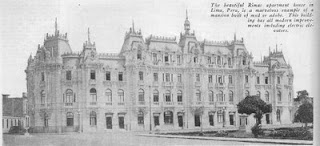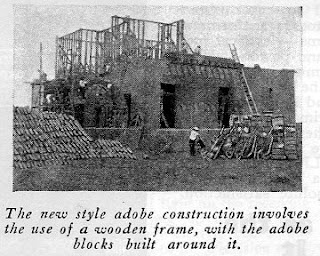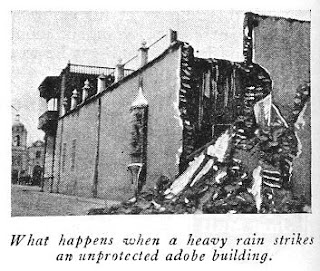
From Science and Invention magazine December, 1929
Mansions of Mud
Would Be Washed Away in First Heavy Rain
By A. Hyatt Verrill
Famous Archeologist and Tropical Explorer
THOUSANDS of years before Columbus the inhabitants of Peru built cities, palaces and temples of mud or adobe. In an almost rainless and treeless land it was the ideal material, and although deserted and exposed to the elements for countless centuries, the massive adobe walls, the immense temples and the houses of the people still remain almost intact and unaltered. The
 Spaniards were quick to profit by the experience of the people they conquered and destroyed and adopted adobe as the material for their own buildings. Practically every edifice of Spanish colonial times in Peru was constructed of mud, and churches, government buildings, palaces, cathedrals and forts were made of this humble material. These earlier mud buildings were constructed by the simple process of piling large adobe bricks or blocks one upon another to form the walls, and in order to support the weight of heavy timbers, floors and roofs, these walls were of necessity enormously thick and massive. Moreover, there was a limit to the height to which such walls could safely be carried. The weight of the adobe itself was enormous, and its resistance to a crushing strain is not very great, and as a result most of the earlier adobe buildings were low and seldom more than two stories in height. Occasionally, however, very imposing buildings were erected, and the great cathedral in Lima is the largest adobe building in the world.
Spaniards were quick to profit by the experience of the people they conquered and destroyed and adopted adobe as the material for their own buildings. Practically every edifice of Spanish colonial times in Peru was constructed of mud, and churches, government buildings, palaces, cathedrals and forts were made of this humble material. These earlier mud buildings were constructed by the simple process of piling large adobe bricks or blocks one upon another to form the walls, and in order to support the weight of heavy timbers, floors and roofs, these walls were of necessity enormously thick and massive. Moreover, there was a limit to the height to which such walls could safely be carried. The weight of the adobe itself was enormous, and its resistance to a crushing strain is not very great, and as a result most of the earlier adobe buildings were low and seldom more than two stories in height. Occasionally, however, very imposing buildings were erected, and the great cathedral in Lima is the largest adobe building in the world.
 For nearly five centuries adobe buildings were made in the same old way, exactly as they had been made by the Indians for thousands of years, but with the demands for modern dwellings and buildings the progressive Peruvians developed an entirely new method of mud-building construction, and today practically all the edifices made of this material are of reinforced adobe. Instead of erecting immense, thick walls of adobe bricks, the modern structure has a framework of light wood covered with a lathing of cane, metal lathes, wire-netting or light steel as a foundation for the mud bricks. By this method large, high and elaborate adobe buildings are erected, and when the outer surfaces have been covered with a stucco of plaster or a coating of sprayed cement, and have been painted and finished with ornamental plaster work, no one would dream that they were of adobe.
For nearly five centuries adobe buildings were made in the same old way, exactly as they had been made by the Indians for thousands of years, but with the demands for modern dwellings and buildings the progressive Peruvians developed an entirely new method of mud-building construction, and today practically all the edifices made of this material are of reinforced adobe. Instead of erecting immense, thick walls of adobe bricks, the modern structure has a framework of light wood covered with a lathing of cane, metal lathes, wire-netting or light steel as a foundation for the mud bricks. By this method large, high and elaborate adobe buildings are erected, and when the outer surfaces have been covered with a stucco of plaster or a coating of sprayed cement, and have been painted and finished with ornamental plaster work, no one would dream that they were of adobe.Such,
 for an example, is the magnificent Rimac apartment building which may aptly be called a "mud-flat" with its beautifully finished interior, its passenger elevators, and every up-to-date convenience. Palatial homes and mansions, office buildings, bungalows and Moorish palaces are all built of reinforced adobe, which in and about Lima still holds its own in competition with concrete, and one ambitious citizen even erected a medieval castle of mud.
for an example, is the magnificent Rimac apartment building which may aptly be called a "mud-flat" with its beautifully finished interior, its passenger elevators, and every up-to-date convenience. Palatial homes and mansions, office buildings, bungalows and Moorish palaces are all built of reinforced adobe, which in and about Lima still holds its own in competition with concrete, and one ambitious citizen even erected a medieval castle of mud.Not only is adobe admi
 rably adapted to Peru's climate; but it is the cheapest and the most abundant of building materials. One has only to mix some water with the soil, and presto! Your house lot becomes the source of material for building a house. But as a rule only the smaller houses are built from the mud on their own grounds. The adobe-brick industry is a very important one, and everywhere about Lima are endless walls of the brown adobe bricks ready for use as occasion demands. And when a house is to be built the workmen move bag and baggage onto the property along with the mud bricks. A niche in the pile of adobes serves as their temporary home, and there they dwell together with their wives and innumerable children like modern cave-dwellers, until the last brick has been used and they move on to the next building-site. Sun, wind, time have little or no effect upon adobe buildings, and they will stand through an earthquake that will crumble and shatter concrete or even wooden houses. But rain is fatal to them. Ordinarily real rain is so rare on the coastal area of Peru that it may be said to be rainless. During the winter there is a misty drizzle, but occasionally heavy showers descend, and woe to the adobe buildings that are not prepared for the phenomenon. A few days of really hard rain would result in a large portion of Lima being reduced to its original mud, as was the case at Trujillo when, three years ago, a series of unprecedented rains fell on that city. Scores of houses and buildings, that had stood unaltered since the days of Pizarro, melted and crumbled to shapeless piles of mud, while scores more became unsafe and were abandoned. But the catastrophe proved a blessing in disguise. It was found that in nearly every case the damage was caused, not by the mud walls dissolving, but by the water spattering from the ground and striking the walls at their bases and thus undermining them. To prevent this a thin coating of cement is now superimposed on the walls of all adobe buildings. This reaches from the ground or a few inches beneath the surface to a height of several feet and effectively protects the soluble adobe from the spattering of any rain.
rably adapted to Peru's climate; but it is the cheapest and the most abundant of building materials. One has only to mix some water with the soil, and presto! Your house lot becomes the source of material for building a house. But as a rule only the smaller houses are built from the mud on their own grounds. The adobe-brick industry is a very important one, and everywhere about Lima are endless walls of the brown adobe bricks ready for use as occasion demands. And when a house is to be built the workmen move bag and baggage onto the property along with the mud bricks. A niche in the pile of adobes serves as their temporary home, and there they dwell together with their wives and innumerable children like modern cave-dwellers, until the last brick has been used and they move on to the next building-site. Sun, wind, time have little or no effect upon adobe buildings, and they will stand through an earthquake that will crumble and shatter concrete or even wooden houses. But rain is fatal to them. Ordinarily real rain is so rare on the coastal area of Peru that it may be said to be rainless. During the winter there is a misty drizzle, but occasionally heavy showers descend, and woe to the adobe buildings that are not prepared for the phenomenon. A few days of really hard rain would result in a large portion of Lima being reduced to its original mud, as was the case at Trujillo when, three years ago, a series of unprecedented rains fell on that city. Scores of houses and buildings, that had stood unaltered since the days of Pizarro, melted and crumbled to shapeless piles of mud, while scores more became unsafe and were abandoned. But the catastrophe proved a blessing in disguise. It was found that in nearly every case the damage was caused, not by the mud walls dissolving, but by the water spattering from the ground and striking the walls at their bases and thus undermining them. To prevent this a thin coating of cement is now superimposed on the walls of all adobe buildings. This reaches from the ground or a few inches beneath the surface to a height of several feet and effectively protects the soluble adobe from the spattering of any rain.Truly, the Peruvians may be said to have glorified mud!



No comments:
Post a Comment